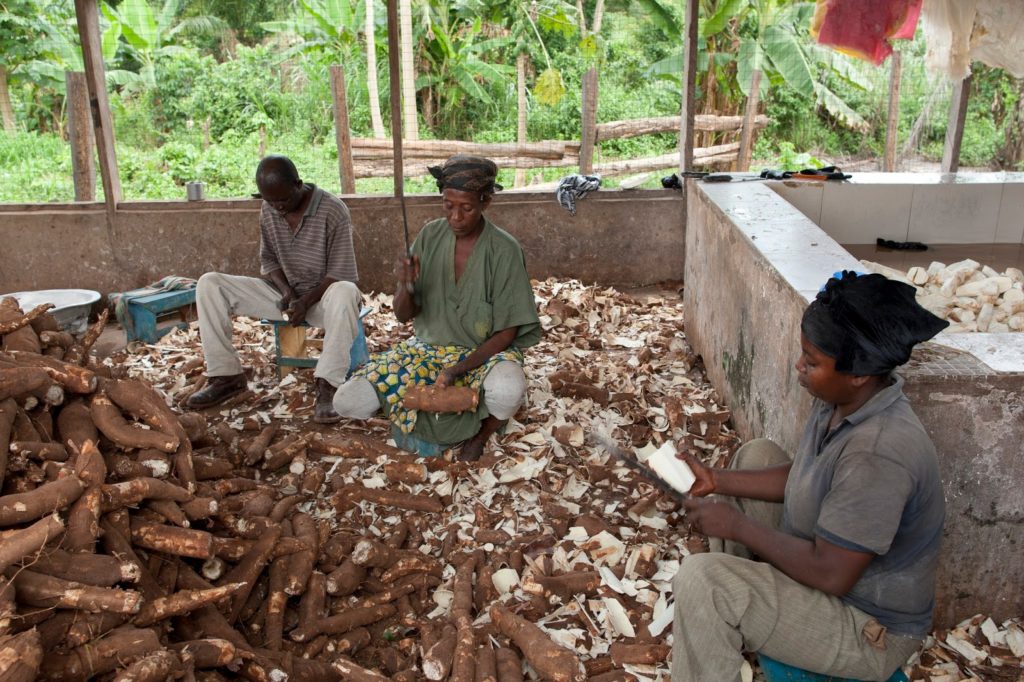By Boaz Opio
Dressed in a traditional attire popularly known as Gomesi, Lovingo Awino walks on a narrow pathway leading to her cassava garden, two hundred metres away from her homestead. The more she drew closer, the more she hears noises of harvesters. It is not an ordinary harvesting day here, but a more labourious one: a mass untimely harvesting with fear, loss and a bit of discontent.
With lamentations of panic, she looks up in the sky for more nimbus starting to gather at the daybreak.
The ‘raped’ garden itself is innocently flourishing—because of excessive rainfall. But this is just what is recouping loses to Lovingo’s five acre of cassava.
It is the aftermath of a week of torrential rains. The women helping in the garden friskily pull out cassava stems, one by one, uprooting them with exaggerated ease, something that would normally be done by a hand hoe or stick.
To make hay when it still shines, other helpers cut the uprooted stems to use them for propagating the crop later on in their own fields, while some freely eat the raw tubers as it is believed it’s healthy for breastfeeding mothers. They welcome Lovingo in a chorus to the field but the owner doesn’t seem happy at all.
Without wasting time, Lovingo joins the taskforce, walking across the water-logged garden, pulling up the plants. The dirt of the stems clearly marked the level at which floods have raised to, conspicuously above the knee-level.
Lovingo is one of the thousands of the affected farmers. When such climatic disasters happen, the entire fields have to be harvested prematurely lest the tubers to rot in the wet ground.
El Niño like this leaves a lot of devastation, including: disruption in imports as trailers remained stranded with Ugandan border points, bridges collapsed, River Nile burst its banks, city roads flooded and reported dysentery and Cholera outbreaks. However, none of all these effects is worse than the disruption on the cassava production as Uganda’s staple food.

When the spring rains returned (wet season in Uganda), Lovingo’s cassava garden was almost drowned. In just two days, the leaves started to become yellowish, the sign of too much rainfall. Growing cassava is the major source of livelihood to Lovingo and her five children. In good yields, sells cassava flour to pay their school fees too.
“Now I have to dry all of them and sell them later for my children’s school fees,” she says with a sigh “this method also allows us to have food throughout the year.”
Typically, most peasant farmers employ a different approach to cassava harvesting. Harvesting is done only periodically in small bits, in times of need. However, with the changing climate and weather patterns, this habit has to be disrupted.
Generally cassava reaches maturity in 9-24 months or up to 36 months depending on the variety, climate and soil conditions. Some quick growing cultivars can be harvested in 6-7 months, but good yields are normally obtained after 9-12 months. It can be grown on a wide range of soil but best on deep, free draining with average yields of 10 – 30 tonnes per acre.
After uprooting about 3 bags of 200 kilograms each, she hires a boda-boda who makes 3 rounds at shillings 3000 (US $0.85) per round to take them to her home. The tubers cannot be stored fresh for a long time therefore sliced and dried in the sun is the best way and it can be kept for long periods of time in a dry bag in a place such as granary or other food stores.
The dry cassava may also be pounded into flour which can be stored for a long period of time in a dry place.
According to Patrick Okaware, the senior district agricultural officer for Tororo, eastern region, “since the crop is tolerant in drought prone areas, farmers in Tororo district who are frustrated by floods can still go ahead to grow the plant. They have to make sure they carry out mass-harvesting in case of floods.”
In a recent interview with the District Senior Agricultural Officer who doubles as a farmer about how cassava planters can cope with the changing climate, he noted that most people in the district feed on cassava as their staple food but the flour is imported from other cassava growing regions such as Arua and other northern Uganda districts. “This makes cassava flour expensive as the traders have to include their transportation costs,” he adds.
Farmers who are affected by the climate impact can use preservation method such as that used by Lovingo to ensure their own food security. According to the ministry of agriculture, food insecurity and famine in Uganda often results from El Niño floods that causes cassava to rot.
Cassava is currently one of the most important staple food crops in the country. Other big producing countries include Nigeria, Cameroon and Central African Republic. Apart from being a the major source of carbohydrates and starch to subsistence farmers, it is also industrially valuable as it is used as a raw material in bakeries, breweries and other food processing firms. Climatic changes that threatens its productivity thus needs rigorous adaptative response such as those practiced by the farmers of Eastern Uganda.




